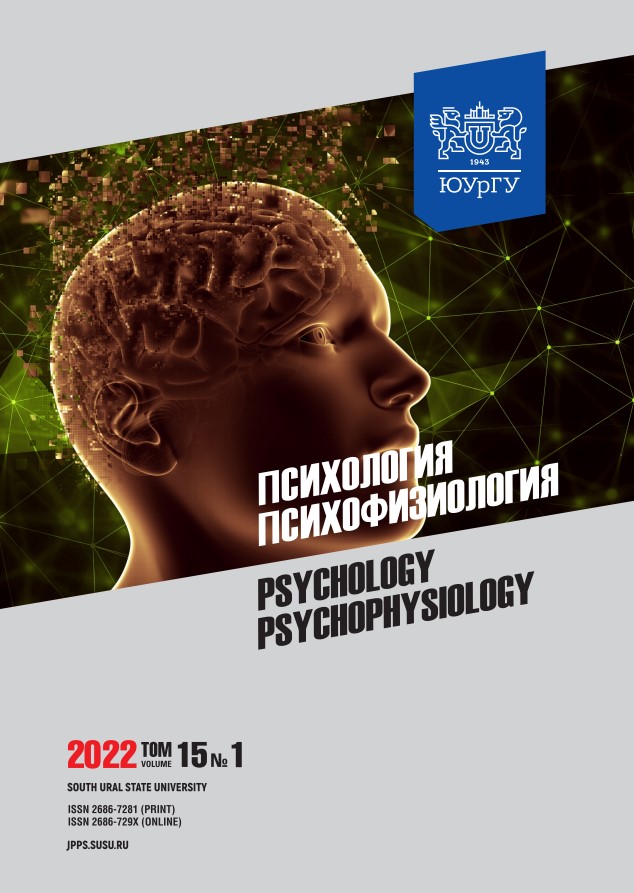Improving the self-regulation and adaptation of students to stress
Abstract
Introduction. in recent years, the progressive increase in the number of psychoemotional and somatic disorders diagnosed in university students has caused great concern. This problem requires new approaches and the use of effective methods for developing students' adaptive resources. Aims. The paper aims to assess the adaptive reactions and self-regulation of university students and develop a method for their improvement with game biofeedback technologies. Materials and methods. The study took place at the pedagogical university and involved 100 female students. 32 female students were included in the experimental part of the study and divided equally into experimental and control groups. During one month, all participants were involved in the program for developing the skill of heart rate control. In the experimental group, training was conducted according to the authors’ methodology. The following methods were used for the purpose of the study: cerebral omega potential (OP) measurement, the assessment of sensorimotor responses, heart rate variability analysis. Results. The paper describes the features of psychophysiological self-regulation and adaptive capabilities of university students. The authors proposed the method for improving adaptive capabilities of university students by optimizing their functional status and developing self-regulation skills in stressful situations. The authors provided scientific justification for the proposed method. Conclusion. The study showed low levels of adaptive mechanisms and self-regulation in a significant number of university students. The proposed method allows for an individual approach to each student by taking into account his/her functional status, which contributes to better improvement of adaptive resources.
Downloads
References
2. Jamieson J.P., Black A.E., Pelaia L.E., Reis H.T. The impact of mathematics anxiety on stress appraisals, neuroendocrine responses, and academic performance in a community college sample. Journal of Educational Psychology. 2020;113(6):1164–1176. DOI: https://doi.org/10.1037/edu0000636
3. Baiguzhin P.A., Kirsanov V.M., Shibkova D.Z. Statistical characteristics of indicators of the functional state of the body of students depending on the level of regulation of educational and professional activities. Vestnik Novosibirskogo gosudarstvennogo pedagogicheskogo universiteta = Bulletin of the Novosibirsk State Pedagogical University. 2017;7(3):223–240. (in Russ.). DOI: https://doi.org/10.15293/2226-3365.1703.14
4. Larionova S.V. The study of emotional-volitional self-regulation in students of universities of the deontological type. Pedagogicheskoe obrazovanie v Rossii = Pedagogical education in Russia. 2018;1:185–190. (in Russ.).
5. Landrum B. Examining Students Confidence to Learn Online, Self-Regulation Skills and Perceptions of Satisfaction and Usefulness of Online Classes. Online Learning. 2020;24(3):128–146. DOI: https://doi.org/10.24059/olj.v24i3.2066
6. Kovac S., Speckmann E.J., Gorji A. Uncensored EEG: the role of DC potentials in neurobiology of the brain. Progress in neurobiology. 2018;165:51–65. DOI: https://doi.org/10.1016/j.pneurobio.2018.02.001
7. Lehrer P., Kaur K., Sharma A., Shah K. et al. Heart rate variability biofeedback improves emotional and physical health and performance: a systematic review and meta analysis. Applied psychophysiology and biofeedback. 2020;45(3)109–129. DOI: https://doi.org/10.1007/s10484-021-09526-y
8. Holzman J.B., Bridgett D.J. Heart rate variability indices as bio-markers of top-down self-regulatory mechanisms: A meta-analytic review. Neuroscience and Biobehavioral Reviews. 2017;74:233–255. DOI: https://doi.org/10.1016/j.neubiorev.2016.12.032
9. Soroko S.I. Trubachev V.V. Neirofiziologicheskie i psikhofiziologicheskie osnovy adaptivnogo bioupravleniya. [Neurophysiological and psychophysiological foundations of adaptive biofeedback]. St. Petersburg: Polytechnic Publ. 2010:594. (in Russ.).
10. Dzhunusova G.S., Sataeva N.U., Sadykova G.S. Predictive assessment of human adaptive capabilities taking into account individual typological features of the central nervous system. Mezhdunarodnyy zhurnal prikladnykh i fundamentalnykh issledovaniy = International Journal of Applied and Fundamental Research. 2018;12(2):235–239. (in Russ.).
11. Menshikova I.A. Physiological foundations of neurobiological management. Potentsial sovremennoy nauki = The potential of modern science. 2017;2:32–34. (in Russ.).
12. Zybin K.D. Physiological significance of the entropy of oscillations of super-slow biopotentials. Nauchnyy vestnik zdravookhraneniya Kubani = Scientific Bulletin of Kuban healthcare. 2018;4:1–6. (in Russ.).
13. Moskovchenko O.N., Shumakov A.V. Individualization of sports training of Greco-Roman style wrestlers based on the omegametry method. Vestnik Krasnoyarskogo gosudarstvennogo pedagogicheskogo universiteta im. V.P. Astafeva = Bulletin of the Krasnoyarsk State Pedagogical University named after V.P. Astafyev. 2018;43(1):127–133. (in Russ.). DOI: https://doi.org/ 10.25146/1995-0861-2018-43-1-46
14. Gribanov A.V., Anikina N.Yu., Kotova O.N. Distribution of cerebral energy processes in young people permanently residing in the Arctic region. Zhurnal mediko-biologicheskikh issledovaniy = Journal of Biomedical Research. 2019;7(1):118–123. (in Russ.). DOI: https://doi.org/ 10.17238/issn2542-1298.2019.7.1.118
15. Lisova N.A., Lukyanova A.A., Kirko V.I. Effective adaptation to stress load: the role of activation mechanisms and typological properties of the nervous system. Uchenye zapiski Krymskogo federalnogo universiteta imeni V.I. Vernadskogo. Biologiya. Khimiya = Scientific notes of the V.I. Vernadsky Crimean Federal University. Biology. Chemistry. 2020;72(2):119–128. (in Russ.).
16. Murik S.E. Omegaelectroencephalography: Formation History and Diagnostic Capabilities of the New Method in Electrophysiology. Izvestiya Irkutskogo gosudarstvennogo universiteta. Seriya Biologiya. Ekologiya = The Bulletin of Irkutsk State University. Series Biology. Ecology. 2018;26:69–85. DOI: https://doi.org/10.26516/2073-3372.2018.26.69 (in Russ.).
17. Kuptsova S.A. Mental self-regulation as a component of health culture. Vestnik Yuzhno-Uralskogo gosudarstvennogo gumanitarno-pedagogicheskogo universiteta = Bulletin of the South Ural State Humanitarian Pedagogical University. 2018;2:221–232. (in Russ.).
18. Demin D.B., Poskotinova L.V. Changes in the spectral characteristics of the electroencephalogram in the process of biofeedback of heart rate variability parameters in healthy individuals. Zhurnal nevrologii i psikhiatrii im. S.S. Korsakova = Journal of Neurology and Psychiatry named after S.S. Korsakov. 2017;117(3):65–68. (in Russ.).
19. Uziel L., Baumeister R.F. The Self-Control Irony: Desire for Self-Control Limits Exertion of Self-Control in Demanding Settings. Personality and Social Psychology Bulletin. 2017;43(5):693–705. DOI: https://doi.org/10.1177/0146167217695555
20. Inzlicht M., Werner K.M., Briskin J.L., Roberts B.W. Integrating models of self-regulation. Annual Review of Psychology. 2021;72:319–345. DOI: https://doi.org/10.1146/annurev-psych-061020-105721
References on translit
-Copyright (c) 2022 Psychology. Psychophysiology

This work is licensed under a Creative Commons Attribution-NonCommercial-NoDerivatives 4.0 International License.



